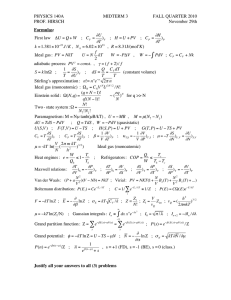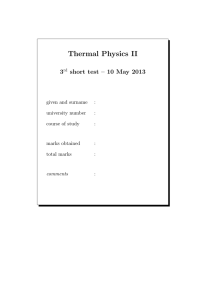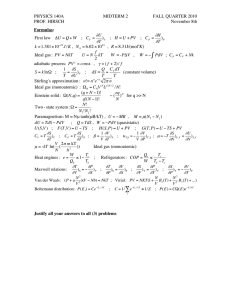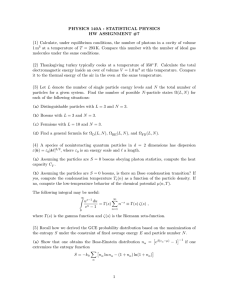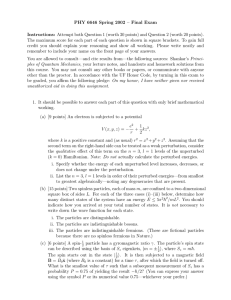$
advertisement
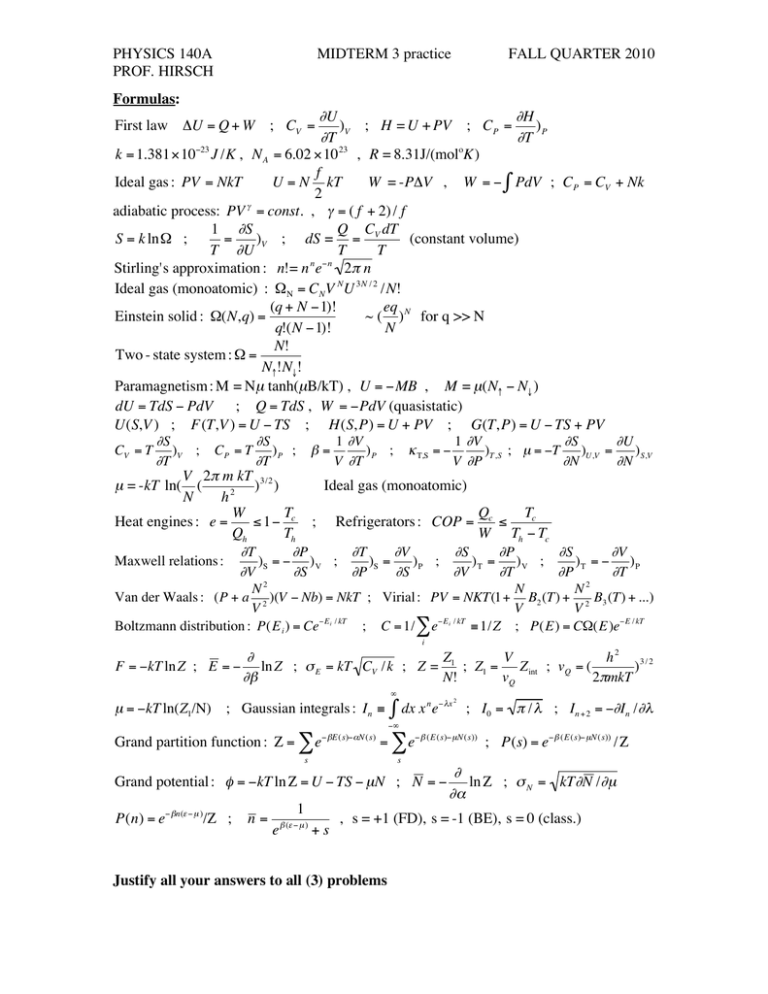
PHYSICS 140A PROF. HIRSCH MIDTERM 3 practice FALL QUARTER 2010 Formulas: #U #H )V ; H = U + PV ; CP = )P #T #T k = 1.381"10#23 J /K , N A = 6.02 "10 23 , R = 8.31J/(moloK) f Ideal gas : PV = NkT U = N kT W = -P"V , W = # $ PdV ; CP = CV + Nk 2 adiabatic process: PV " = const. , " = ( f + 2) / f 1 #S Q C dT S = k ln" ; = )V ; dS = = V (constant volume) T #U T T Stirling's approximation : n!= n n e"n 2# n ! Ideal gas (monoatomic) : "N = CNV NU 3N / 2 /N! (q + N #1)! eq Einstein solid : "(N,q) = ~ ( ) N for q >> N q!(N #1)! N N! Two - state system : " = N#!N$! Paramagnetism : M = Nµ tanh(µB/kT) , U = "MB , M = µ(N# " N$ ) dU = TdS " PdV ; Q = TdS , W = "PdV (quasistatic) U(S,V ) ; F(T,V ) = U " TS ; H(S,P) = U + PV ; G(T,P) = U " TS + PV First law "U = Q + W ; CV = ! ! ! ! ! ! ! ! ! ! ! ! ! ! ! ! ! "S "S 1 "V 1 "V "S "U )V ; C P = T ) P ; # = ) P ; $ T,S = % )T ,S ; µ = %T )U ,V = ) S,V "T "T V "T V "P "N "N V 2" m kT 3/2 µ = -kT ln( ( ) ) Ideal gas (monoatomic) N h2 W T Q Tc Heat engines : e = " 1# c ; Refrigerators : COP = c " Qh Th W Th # Tc "T "P "T "V "S "P "S "V Maxwell relations : )S = # ) V ; )S = )P ; )T = )V ; )T = # )P "V "S "P "S "V "T "P "T 2 2 N N N Van der Waals : (P + a 2 )(V " Nb) = NkT ; Virial : PV = NKT(1+ B2 (T) + 2 B3 (T) + ...) V V V Boltzmann distribution : P(E i ) = Ce"E i / kT ; C = 1/ # e"E i / kT $ 1/Z ; P(E) = C%(E)e"E / kT CV = T i # Z V h2 3/2 F = "kT ln Z ; E = " ln Z ; % E = kT CV /k ; Z = 1 ; Z1 = Z int ; vQ = ( ) #$ N! vQ 2&mkT % µ = "kT ln(Z1/N) ; Gaussian integrals : In # n " $x 2 & dx x e ; I0 = ' / $ ; In +2 = "(In /($ "% ! Grand partition function : " = & e# $E(s)#%N (s) = & e# $ (E (s)# µN (s)) ; P(s) = e# $ (E (s)# µN(s)) /" s s ! Grand potential : " = #kT ln $ = U # TS # µN ; N = # ! P(n) = e" #n($ " µ )/% ; n= 1 e # ($ " µ ) +s , s = +1 (FD), s = -1 (BE), s = 0 (class.) ! ! % ln $ ; ' N = kT%N /%µ %& Justify all your answers to all (3) problems PHYSICS 140A PROF. HIRSCH MIDTERM 3 practice FALL QUARTER 2010 Problem 1 A particle can be in one of three energy states, of energy 0, ε and 3ε and degeneracy 1, 2 and 2 respectively. (a) Find the average energy of this particle at infinite temperature. (b) At what temperature is the average energy of this particle ε? (c) At what temperature is this particle twice as likely to be in a state with energy ε than to be in a state with energy 3ε? (d) At what temperature does this particle have a 99.9% chance to be in the ground state? Your answer may be slightly approximate. (e) What is the entropy of this system at infinite temperature? (f) What is the entropy of this system at zero temperature? For the temperature found in (b), for which the average energy of this particle is ε: (g) What is the value of the partition function Z? (h) What is the value of the Helmholtz free energy F? (i) What is the value of the entropy? Problem 2 A diatomic molecule composed of distinguishable atoms has rotational energy levels E r ( j) = "r j( j + 1) of degeneracy (2j+1), with j=0, 1, 2, 3..., and εr=0.001eV. It also can vibrate along the line connecting the two atoms, with the energy difference between two neighboring vibrational energy levels being 0.01eV. ! For temperature kT=0.01eV: (a) Find the rotational partition function (approximately) (b) Find the vibrational partition function, ignoring zero point vibrations. (c) Find the internal partition function ignoring electronic degrees of freedom (d) Find the average rotational energy in eV. (e) Find the average vibrational energy in eV. (f) Find the heat capacity per molecule For temperature kT=0.0001eV: (g) Find the average energy approximately, ignoring zero point vibration, in eV. Your result should not be zero. Problem 3 A system has two single-particle energy levels, one with energy 0 and one with energy ε. (a) Assuming the system has exactly 2 particles, how many states does this system have if the two particles are (i) fermions, (ii) bosons, (iii) classical distinguishable? (b) What is the total number of states that this system can have if the particles are fermions, but their number is not fixed? (c) What is the total number of states that this system can have if the particles are bosons, but their number is not fixed? PHYSICS 140A PROF. HIRSCH MIDTERM 3 practice FALL QUARTER 2010 If the particles are fermions: (d) Write down the grand partition function for this system. It should have 4 terms. (e) Find an expression for the average number of particles by direct calculation. Use N = $ N(s)e" # (E (s)" µN(s)) /% s ! (f) Evaluate the result in (e) for the case µ=ε/2. (g) Calculate the average occupation for the two energy levels using Eq. 7.23 in the book, add them, and compare with the result in (e). Assume now the particles are bosons, and the average number is N = 10,000 . Assume kT =ε. (h) Find the chemical potential µ. The calculation may be slightly approximate. (i) For the case of (h), find approximately the number of particles in the two energy ! levels. Assume now the temperature is very high, e.g. take kT=1000ε. For high temperatures one can usually use classical statistics (Maxwell Boltzmann statistics. Assume again the average number of particles is N = 10,000 . Using classical statistics, (j) What is the value of the chemical potential? (k) What is the average occupation of the two energy levels? ! Problem 1 answers: (a) 1.6ε (b) kT=2.164ε (c)kT=2.885ε (d)kT=0.132ε (e) 1.609k (f) 0 (g) 2.76 (h) -2.197ε (i) 1.477k Problem 2 answers: (a) 10 (b) 1.582 (c) 15.82 (d) 0.01eV (e) 0.0058 eV (f) 2.84k (=1.5k+.34k+1k) (g) 1.24x10-11 eV Problem 3 answers: (a) 1, 3, 4 (b) 4 PHYSICS 140A PROF. HIRSCH (c) infinite (d) (e) (f) 1 (g) should be same (h) =-0.0001kT. (i) ~10,000, ~1.7 (j) µ=8.5 ε (k) 5,000 each MIDTERM 3 practice FALL QUARTER 2010
